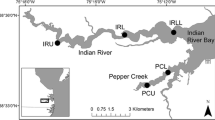Abstract
Human and industrial activities in Arctic areas are increasing, as are global water temperatures. Combined, these factors can result in altered conditions for species living in these, until recently, pristine areas. Of the anadromous salmonids, Arctic charr may be particularly vulnerable to these changes, as this species is adapted to cold waters and exploits restricted areas at sea. In order to test to what extent Arctic charr utilized coastal areas with anthropogenic interference versus more pristine waters, the marine area use of a population in northern Norway was documented over three consecutive years by use of acoustic telemetry. Their depth utilization, temperature preference and survival was also recorded. The tagged fish spent a minimum of half of their marine residency time within 5 km of the river outlet proximate to urbanized coastal areas. The fish also resided within a narrow temperature and depth range and spent a very limited period at sea. The marine habitat available to Arctic charr should be carefully considered in coastal development and management plans, as human activities and coastal water temperatures increase in the Arctic regions. The current study illustrates the importance of species and population-specific knowledge during development of management strategies for anadromous salmonids.





Similar content being viewed by others
References
Anon., 2011. The status of Norwegian salmon stocks in 2011. Report from the Norwegian Scientific Advisory Committee for Atlantic Salmon Management 3, 285 pp (in Norwegian with English summary).
Båmstedt, U., 1998. Trophodynamics of Pleurobrachia pileus (Ctenophora, Cydippida) and ctenophore summer occurrence off the Norwegian North-West coast. Sarsia 83: 169–181.
Berg, O. K. & M. Berg, 1989. Sea growth and time of migration of anadromous Arctic char (Salvelinus alpinus) from the Vardnes River, in northern Norway. Canadian Journal of Fisheries and Aquatic Sciences 46: 955–960.
Berg, O. K. & M. Berg, 1993. Duration of sea and freshwater residence of Arctic char (Salvelinus alpinus), from the Vardnes River in northern Norway. Aquaculture 110: 129–140.
Berg, O. K. & B. Jonsson, 1989. Migratory patterns of anadromous Atlantic salmon, brown trout, and Arctic charr from the Vardnes River in northern Norway. In Brannon, E. & B. Jonsson (eds), Proceedings of the Salmonid Migration and Distribution Symposium, Seattle. School of Fisheries, University of Washington: 106–115.
Brooks, M. L., E. Fleishman, L. R. Brown, P. W. Lehman, I. Werner, N. Scholz, C. Mitchelmore, J. R. Lovvorn, M. L. Johnson, D. Schlenk, S. van Drunick, J. I. Drever, D. M. Stoms, A. E. Parker & R. Dugdale, 2012. Life histories, salinity zones, and sublethal contributions of contaminants to pelagic fish declines illustrated with a case study of San Francisco Estuary, California, USA. Estuaries and Coasts 35: 603–621.
Cargnelli, L. M. & M. R. Gross, 1996. The temporal dimension in fish recruitment: birth date, body size, and size-dependent survival in a sunfish (bluegill: Lepomis macrochirus). Canadian Journal of Fisheries and Aquatic Sciences 53: 360–367.
Dempson, J. B. & A. H. Kristofferson, 1987. Spatial and temporal aspects of the ocean migration of anadromous Arctic charr. American Fisheries Society Symposium 1: 340–357.
Dempson, J. B., M. Shears & M. Bloom, 2002. Spatial and temporal variability in the diet of anadromous Arctic charr, Salvelinus alpinus, in northern Labrador. Environmental Biology of Fishes 64: 49–62.
Døving, K. B., H. Westerberg & P. B. Johnsen, 1985. Role of olfaction in the behavioral and neuronal responses of Atlantic salmon, Salmo salar, to hydrographic stratification. Canadian Journal of Fisheries and Aquatic Sciences 42: 1658–1667.
Dulvy, N. K., S. I. Rogers, S. Jennings, V. Stelzenmüller, S. R. Dye & H. R. Skjoldal, 2008. Climate change and deepening of the North Sea fish assemblage: a biotic indicator of warming seas. Journal of Applied Ecology 45: 1029–1039.
Finstad, A. G. & C. L. Hein, 2012. Migrate or stay: terrestrial primary productivity and climate drive anadromy in Arctic char. Global Change Biology 18: 2487–2497.
Grønvik, S. & A. Klemetsen, 1987. Marine food and diet overlap of co-occurring Arctic charr Salvelinus alpinus (L.), brown trout Salmo trutta L. and Atlantic salmon S. salar L. off Senja, N. Norway. Polar Biology 7: 173–177.
Gross, M. R., R. M. Coleman & R. M. McDowall, 1988. Aquatic productivity and the evolution of diadromous fish migration. Science 239: 1291–1293.
Harwood, L. A. & J. A. Babaluk, 2014. Spawning, overwintering and summer feeding habitats used by anadromous Arctic char (Salvelinus alpinus) of the Hornaday River, Northwest Territories, Canada. Arctic 67: 449–461.
Huntley, M. E. & M. D. G. Lopez, 1992. Temperature-dependent production of marine copepods: a global synthesis. The American Naturalist 140: 201–242.
Iversen, M., B. Finstad, R. S. McKinley & R. A. Eliassen, 2003. The efficacy of metomidate, clove oil, Aqui-S (TM) and Benzoak (R) as anaesthetics in Atlantic salmon (Salmo salar L.) smolts, and their potential stress-reducing capacity. Aquaculture 221: 549–566.
Jensen, J. L. A. & A. H. Rikardsen, 2008. Do northern riverine anadromous Arctic charr Salvelinus alpinus and sea trout Salmo trutta overwinter in estuarine and marine waters? Journal of Fish Biology 73: 1810–1818.
Jensen, J. L. A. & A. H. Rikardsen, 2012. Archival tags reveal that Arctic charr Salvelinus alpinus and brown trout Salmo trutta can use estuarine and marine waters during winter. Journal of Fish Biology 81: 735–749.
Jensen, J. L. A., A. H. Rikardsen, E. B. Thorstad, A. H. Suhr, J. G. Davidsen & R. Primicerio, 2014. Water temperatures influence the marine area use of Salvelinus alpinus and Salmo trutta. Journal of Fish Biology 84: 1640–1653.
Jobling, M., 1994. Fish Bioenergetics. Chapman and Hall, London.
Klemetsen, A., P.-A. Amundsen, J. B. Dempson, B. Jonsson, N. Jonsson, M. F. O’Connell & E. Mortensen, 2003. Atlantic salmon Salmo salar L., brown trout Salmo trutta L. and Arctic charr Salvelinus alpinus (L.): a review of aspects of their life histories. Ecology of Freshwater Fish 12: 1–59.
Kramvik, E. O. & D. I. Roti, 2014. Helhetlig tiltaksplanlegging i Hammerfest havn [available on internet at http://www.hammerfest.no/prosjekt-ren-havn-helhetlig-tiltaksplanlegging-i-hammerfest-havn.5663584-341191.html (accessed 9 August 2015, in Norwegian).
Larsson, S., 2005. Thermal preference of Arctic charr, Salvelinus alpinus, and brown trout, Salmo trutta – implications for their niche segregation. Environmental Biology of Fishes 73: 89–96.
Lassalle, G. & E. Rochard, 2009. Impact of twenty-first century climate change on diadromous fish spread over Europe, North Africa and the Middle East. Global Change Biology 15: 1072–1089.
Morris, C. & J. M. Green, 2012. Migrations and harvest rates of Arctic charr (Salvelinus alpinus) in a marine protected area. Aquatic Conservation: Marine and Freshwater Ecosystems 22: 743–750.
Quinn, P. P. & K. W. Myers, 2004. Anadromy and the marine migrations of Pacific salmon and trout: Rounsefell revisited. Reviews in Fish Biology and Fisheries 14: 421–442.
Rapport, D. J., 1989. Symptoms of pathology in the Gulf of Bothnia (Baltic Sea): ecosystem response to stress from human activity. Biological Journal of the Linnean Society 37: 33–49.
Rikardsen, A. H. & P.-A. Amundsen, 2005. Pelagic marine feeding behaviour of Arctic charr Salvelinus alpinus and sea trout Salmo trutta. Journal of Fish Biology 66: 1163–1166.
Rikardsen, A. H., M.-A. Svenning & A. Klemetsen, 1997. The relationships between anadromy, sex ratio and parr growth of Arctic charr in a lake in North Norway. Journal of Fish Biology 51: 447–461.
Rikardsen, A. H., P.-A. Amundsen, P. A. Bjørn & M. Johansen, 2000. Comparison of growth, diet and food consumption of sea-run and lake-dwelling Arctic charr. Journal of Fish Biology 57: 1172–1188.
Rikardsen, A. H., J. B. Dempson, P.-A. Amundsen, P. A. Bjørn, B. Finstad & A. J. Jensen, 2007a. Temporal variability in marine feeding of sympatric Arctic charr and sea trout. Journal of Fish Biology 70: 837–852.
Rikardsen, A. H., J. M. Elliott, J. B. Dempson, J. Sturlaugsson & A. J. Jensen, 2007b. The marine temperature and depth preferences of Arctic charr (Salvelinus alpinus) and sea trout (Salmo trutta), as recorded by data storage tags. Fisheries Oceanography 16: 436–447.
Scott, G. R. & K. A. Sloman, 2004. The effects of environmental pollutants on complex fish behaviour: integrating behavioural and physiological indicators of toxicity. Aquatic Toxicology 68: 369–392.
Spares, A. D., M. J. W. Stokesbury, R. K. O’Dor & T. A. Dick, 2012. Temperature, salinity and prey availability shape the marine migration of Arctic char, Salvelinus alpinus, in a macrotidal estuary. Marine Biology 159: 1633–1646.
Winfield, I. J., J. Hateley, J. M. Fletcher, J. B. James, C. W. Bean & P. Clabburn, 2010. Population trends of Arctic charr (Salvelinus alpinus) in the UK: assessing the evidence for a widespread decline in response to climate change. Hydrobiologia 650: 55–65.
Acknowledgments
We thank Tor Harry Bjørn, Terje Johansen and other people providing technical assistance in the field, and Lois Harwood and an Anonymous Reviewer for comments on the manuscript. Financial support was provided by the County Governor in Finnmark, Statoil ASA, Vest-Finnmark Jeger- og Fiskerforening, FRAM-High North Research Centre for Climate and the Environment, Hammerfest Municipality, the Norwegian Institute for Water Research (NIVA) and Akvaplan-niva. The study was conducted in accordance with national animal care guidelines and was approved by the Norwegian National Animal Research Authority.
Author information
Authors and Affiliations
Corresponding author
Additional information
Guest editors: M. Power, R. Knudsen, C. Adams, M. J. Hansen, J. B. Dempson, M. Jobling & M. Ferguson / Advances in Charr Ecology and Evolution
Rights and permissions
About this article
Cite this article
Jensen, J.L.A., Christensen, G.N., Hawley, K.H. et al. Arctic charr exploit restricted urbanized coastal areas during marine migration: Could they be in harm’s way?. Hydrobiologia 783, 335–345 (2016). https://doi.org/10.1007/s10750-016-2787-6
Received:
Revised:
Accepted:
Published:
Issue Date:
DOI: https://doi.org/10.1007/s10750-016-2787-6




